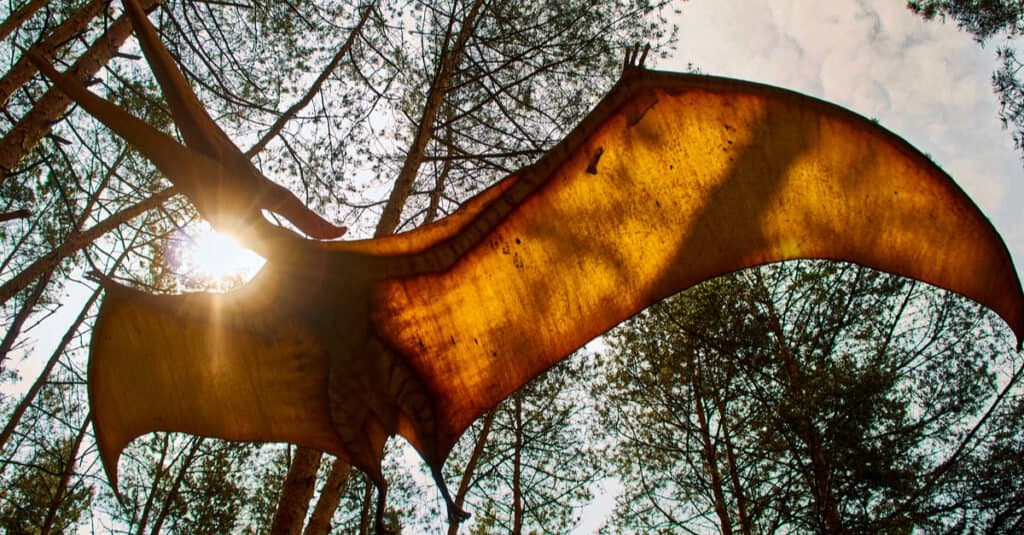Pterodactyls (Pterodactylus antiquus) are extinct flying reptiles. They lived from the Late Jurassic period to the Late Cretaceous period, between 164 million and 64 million years ago. Though they might look similar, they’re actually not dinosaurs. They’re related, but distinct. Pterodactyls belong to the Pterosauria Order–a group of flying reptiles that encompasses around 30 known species. Scientists have pieced together many aspects of the behavior and life cycle of these fascinating creatures–including what they likely ate.
Here, we’ll learn more about what pterodactyls ate and how they hunted for their food. Then, we’ll compare their diets to the diets of some of their pterosaur cousins, and find out just what kinds of creatures may have competed with them for food. Finally, we’ll take a closer look at whether or not pterodactyls (or any of their flying cousins) would have been dangerous to humans.
The Pterodactyl Diet
Pterodactyls were smaller than you might think; scientists estimate that adults were about the size of a housecat, with a wingspan under four feet. There are only a few fossil specimens of the species, but paleontologists have undertaken incredible studies to find out just what these undersized flyers ate.
Pterodactyls ate mostly invertebrates and small vertebrates; they were most likely carnivores. Given their small size, scientists can determine that their prey size was limited, but likely included any small creature unfortunate enough to find itself in the shadow of the pterodactyl.

©Catmando/Shutterstock.com
Caption: Pterodactyls ate mostly invertebrates and small animals, they were likely opportunistic carnivores.
A Complete List of Pterodactyl Foods
Scientists can’t be certain, but it’s also possible that pterodactyls ate small dinosaurs. They may have even eaten other pterodactyls. What is known about their diet has been pieced together by studies on fossils of pterodactyls, as well as by comparisons with extant creatures. By comparing pterodactyls to other, modern, animals of similar size and form, they can make educated guesses as to what these extinct flying reptiles ate. It is likely, however, that they made use of whatever resources they could find, including eggs and carrion meat.
Each species of pterosaur had its own unique skull, tooth, and beak structure. This was largely determined by what that species ate. Scientists can make educated guesses about diet based on the teeth and skulls, but they can get even more information from the teeth. Microscopic studies of pterodactyl teeth reveal that they likely ate lots of insects and molluscs, beyond that, scientists can’t be certain.
How Did Pterodactyls Hunt?
Early pterodactyls likely ate mostly invertebrates, like insects and molluscs. It wasn’t until later in their evolution that scientists think their diets shifted more towards fish and small animals. Based on the shape of their skulls, and the type of teeth they had–it’s likely that pterodactyls hunted their prey in many of the same ways that modern predatory birds hunt.
For fish, this likely meant that pterodactyls flew high overhead, watching the waters until they caught the movement of a fish near the surface. Then, in a swooping dive, they would have plummeted down on the fish from above. Before the fish knew it was in danger, it was in the pterodactyl’s mouth, held secure by their dagger-like teeth.
For terrestrial creatures, pterodactyls almost certainly hunted from the air. Their elongated wings and small back legs would have made long distance walking ungainly, and unfeasible for hunting. They probably had good eyesight, like modern bald eagles, and could see prey from high up, floating on the air currents. Once sighted, they would have swooped down from above, tackling the unfortunate creature with teeth and claws.
What Did Other Pterosaurs Eat?

©Ekaterina Glazkova/Shutterstock.com
Pterodactyls only grew to about the size of a golden eagle, and could eat only small prey. But, other members of the pterosauria order grew bigger–much bigger.
One such relative was the Quetzalcoatlus northropi, a species of pterosaur that had a wingspan over thirty feet. But, scientists aren’t actually sure if this giant pterosaur actually flew. Little is known about them, but based on the weight of their skeletons, some scientists think that they acted (and hunted) more like today’s storks and cranes.
Quetzalcoatlus had a long, sharp bill similar to modern hornbills. It’s estimated that they fed on small creatures like mammals and other birds. Instead of flying to great heights, like pterodactyls likely did, these giants probably only glided short distances. They would have been able to eat larger prey than the pterodactyl, and may even have preyed on a pterodactyl or two.
What Animals Competed With Pterodactyls?
Birds lived right alongside dinosaurs. They shared the skies with pterodactyls, and scientists think they probably competed for food sources. Some scientists even think that this competition drove pterodactyls to branch out in terms of their diet. Some became fish specialists, while others became terrestrial prey specialists, all because of competition with birds.
Because so little is known about pterodactyls, scientists can’t say for sure whether they competed with dinosaurs for food or not. But, they occupied the same habitats as dinosaurs–many of which would have been happy to raid a pterodactyl nest, or make a meal of a resting pterodactyl adult.
Pterodactyls likely had to keep their nests safe from other creatures–this means they probably took some care of their young. Modern birds feed their young until they’re old enough to leave the nest, and it’s possible that pterodactyls did the same thing with their little ones. They would have fed them regurgitated meals of insects, invertebrates, and small creatures.
Could A Pterodactyl Eat a Human?
Hollywood might portray pterodactyls as huge and bloodthirsty, but, in fact–they were small, and probably ate about the same things as a modern hawk. They would have posed no danger to humans. Even the larger Quetzalcoatlus northropi likely wouldn’t have preyed on, or eaten, humans.
The photo featured at the top of this post is © Ekaterina Glazkova/Shutterstock.com
Thank you for reading! Have some feedback for us? Contact the AZ Animals editorial team.






